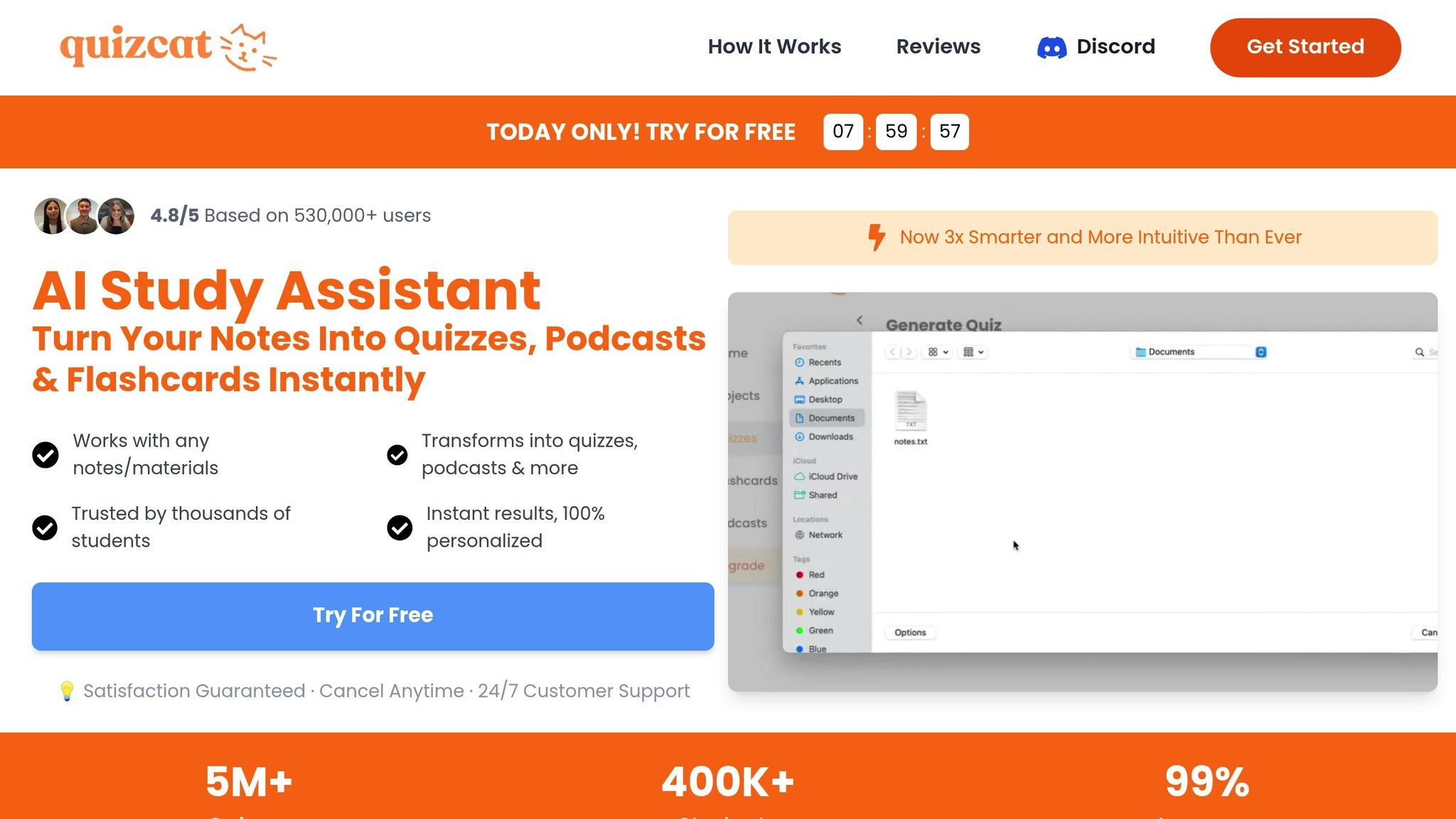
How Predictive Models Analyze Learner Behavior
Predictive models are transforming education by making learning more tailored and efficient. They analyze data like study habits and performance to create personalized tools such as quizzes, flashcards, and audio notes. A popular example is QuizCat AI, used by over 400,000 students, which boasts a 99% accuracy rate in generating customized study materials.
Key Takeaways:
- Personalized Learning: Models identify gaps and preferences to improve study outcomes.
- Real-Time Insights: Track engagement and adjust content to meet individual needs.
- Privacy Focus: Advanced encryption protects sensitive student data.
Quick Overview:
| Feature | Benefit |
|---|---|
| Dynamic Quiz Generation | Tailored quizzes based on uploaded notes |
| Adaptive Flashcards | Adjusts frequency for better retention |
| Smart Audio Learning | Converts notes into audio for on-the-go study |
Predictive models are not just improving how students learn - they’re also addressing privacy and fairness challenges to ensure responsible use of technology.
Student Behavior Data Analysis
Education Data Categories
Predictive models in educational tools depend on diverse data points to better understand and improve student learning experiences. QuizCat AI focuses on two key types of data to create personalized study resources:
- Uploaded Study Materials: Students can upload their notes, which the platform analyzes to generate interactive learning tools like quizzes, flashcards, and even podcasts.
- User Interaction Data: The system monitors how students use these tools, particularly their engagement with quizzes and flashcards, to refine and adapt its recommendations.
"I can listen to my notes like a podcast on the bus, making studying more convenient."
- Olivia Brooks, July 2024
Data Privacy in Education
Protecting student data is a critical concern in educational technology. QuizCat AI prioritizes security by employing cutting-edge encryption methods to safeguard uploaded content. Here's how it works:
| Security Measure | Purpose | Implementation |
|---|---|---|
| Advanced Encryption | Secures uploaded materials | Real-time encryption during both transfer and storage |
To comply with FERPA regulations and ensure students have control over their personal data, QuizCat AI provides options to cancel subscriptions and manage account information directly through its settings, with no penalties. At the same time, its AI continues to analyze uploaded notes to generate study aids while adhering to strict security protocols. These rigorous privacy measures ensure both data protection and the integrity of the predictive modeling process.
With these safeguards in place, QuizCat AI can confidently refine its study recommendations to better suit individual learning needs.
Predictive Model Methods
Common Machine Learning Methods
Once student behavior is analyzed, predictive model methods step in to transform that data into practical learning aids. These methods utilize insights from the analysis to create study tools that students can actively use. For instance, advanced educational models leverage AI algorithms to turn study materials into interactive formats. A great example of this is QuizCat AI, which uses these techniques to craft personalized quizzes. These quizzes are designed to test understanding and strengthen key concepts.
Behavioral Analysis through Machine Learning | Exclusive Lesson
sbb-itb-1e479da
Predictive Models in Practice
Predictive models are changing the way students approach learning by offering highly personalized educational tools. By turning data analysis and modeling concepts into practical solutions, these models are making study methods more targeted and effective.
Custom Study Plans
Today’s predictive models shine at creating study plans that adapt to individual progress. They analyze how students learn, pinpoint areas where they struggle, and then design exercises to address those gaps. A great example of this is QuizCat AI, a platform that takes uploaded study materials and transforms them into quizzes tailored to the user. By focusing on areas that need improvement, it ensures a more effective learning process.
Tracking Student Engagement
Another strength of predictive models is their ability to monitor how students interact with their study materials. By analyzing engagement patterns in real time, these systems can detect when a student might be struggling - long before it becomes a bigger issue. Key metrics include:
- Time spent on specific topics
- Patterns of correct and incorrect answers
- Learning speed and overall progress
- Frequency of interactions with study materials
These insights not only help students stay on track but also fuel the adaptive features that platforms like QuizCat AI provide.
Predictive Features in QuizCat AI

QuizCat AI combines insights from tailored study plans and engagement tracking to offer features that truly enhance the learning experience. With over 400,000 students using the platform worldwide, it delivers three standout tools:
- Dynamic Quiz Generation: The system analyzes uploaded notes to create quizzes that match the student’s current understanding.
- Adaptive Flashcards: Flashcards automatically adjust how often they appear based on the student’s performance, helping with long-term retention.
- Smart Audio Learning: Study materials are converted into natural-sounding audio, perfect for learning on the go.
"The quizzes it makes from my notes are so spot-on. My test scores have gone up, and I actually enjoy studying now. Who even am I? 😅" - Sophia Martinez
These features highlight how AI-powered platforms like QuizCat AI are transforming studying into a more efficient and personalized process for students everywhere.
Risks and Ethics
Understanding the ethical landscape is essential to safeguard student privacy and uphold their rights.
Preventing Model Bias
Algorithmic bias is a significant hurdle in educational predictive modeling. For example, historical biases in data can lead to certain demographic groups being incorrectly categorized as "at-risk".
To address this issue, here are some key practices:
- Conducting regular bias audits using diverse datasets
- Applying fairness constraints during model development
- Continuously monitoring outcomes across varied student groups
- Including diverse perspectives in development teams
While addressing bias is critical, protecting student data is equally important.
Student Data Protection
Handling sensitive educational data requires strict security protocols and compliance with FERPA. Here are some examples of the types of data and their privacy considerations:
| Data Type | Privacy Considerations |
|---|---|
| Learning Disabilities | Requires heightened protection due to sensitivity |
| Behavioral Observations | Could lead to stigmatization if mishandled |
| Socioeconomic Indicators | Risk of unfairly influencing predictions |
| Academic Performance | Can have lasting effects on student opportunities |
To safeguard this data, institutions should implement the following measures:
- Encryption and secure authentication mechanisms
- Adherence to data minimization principles
- Routine security audits to identify vulnerabilities
- Transparent privacy policies, offering clear opt-out options
These steps are crucial for ensuring predictive models enhance personalized learning while maintaining student integrity. Open communication about data collection and usage fosters trust and encourages the responsible application of predictive technologies in education.
Conclusion
Key Takeaways
Predictive models are reshaping education by enabling more personalized and responsive learning experiences. Research shows that targeted predictive interventions can lead to a 10–15% increase in course completion rates.
Here’s how predictive modeling is making a difference:
| Area | Impact | Outcome |
|---|---|---|
| Early Intervention | Flags students at risk during their progress | 20% higher completion rates in MOOCs |
| Personalized Learning | Adjusts content to match learning patterns | 5–10% improvement in test scores |
| Resource Allocation | Prioritizes educational support effectively | More efficient use of teaching resources |
These advancements highlight how early detection, tailored learning paths, and smarter resource distribution can create tangible improvements in education. For instance, QuizCat AI showcases these benefits by adapting content intelligently and recommending targeted practice based on performance analytics.
Such achievements are setting the stage for even more exciting developments in education.
Looking Ahead
The future of predictive modeling in education is brimming with potential. Emerging technologies like advanced natural language processing (NLP) and multimodal analysis will enable systems to interpret text, video, audio, and even physical interactions for deeper learning assessments. Emotion recognition tools will add another layer by tracking student engagement in real time and adjusting content instantly. Meanwhile, virtual and augmented reality will create immersive, adaptive learning spaces.
Privacy concerns will also steer innovation. Federated learning, which allows models to learn from decentralized data without compromising sensitive information, is expected to gain traction. Alongside this, advances in explainable AI will make these systems more transparent and easier to trust for both educators and students.
These advancements promise to make education not just smarter, but also more inclusive and responsive to individual needs.
FAQs
How do predictive models protect student privacy and ensure data security while analyzing learning behavior?
Predictive models are built with strong privacy and security protocols to safeguard student information. They often rely on anonymized or aggregated data, which helps ensure that individual identities are not exposed during the analysis process.
To further protect sensitive information, advanced encryption techniques and secure data storage systems are used. Additionally, these models adhere to strict privacy regulations, such as the Family Educational Rights and Privacy Act (FERPA) in the United States, guaranteeing that student data is managed responsibly and ethically.
What data do predictive models like QuizCat AI use to create personalized learning experiences?
Predictive models, like QuizCat AI, take your uploaded study materials and notes and turn them into a personalized learning experience. By pinpointing essential concepts, spotting patterns, and recognizing areas where you might struggle, these models generate tailored resources - think quizzes, flashcards, or even podcasts.
This method keeps your study sessions focused on what matters most, helping you tackle tough subjects while building on what you already know. It's a more targeted and efficient way to learn.
How do predictive models identify learning gaps and help students improve before challenges arise?
Predictive models dive deep into patterns of learner behavior - like quiz results, study routines, and participation levels - to spot potential learning challenges early. By pinpointing areas where students might face difficulties, these models offer practical insights to tackle issues before they escalate.
With platforms such as QuizCat AI, students gain access to tailored quizzes, flashcards, and other tools aimed at addressing their specific weak points. This approach creates a more targeted and productive learning journey, keeping students aligned with their academic objectives.
